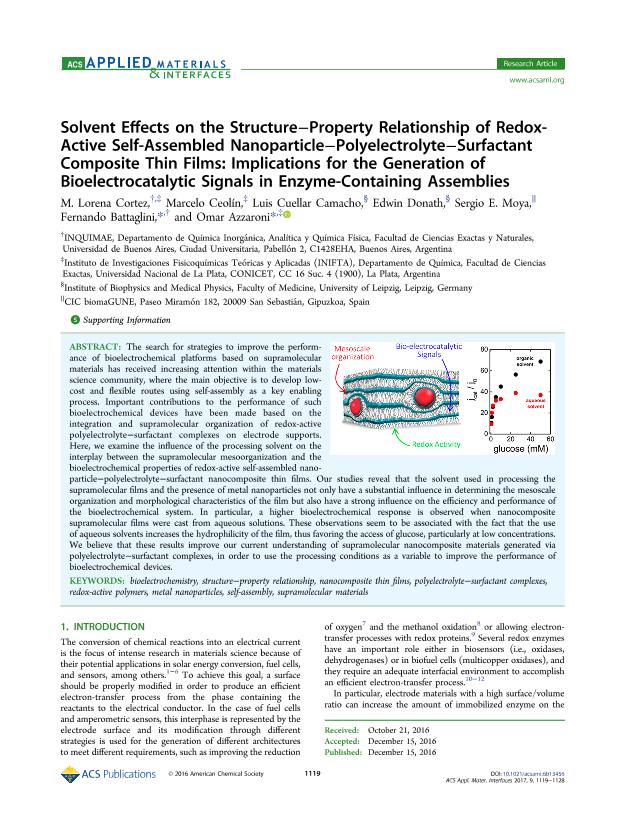Artículo
Solvent effects on the structure-property relationship of redox-Active self-Assembled nanoparticle-polyelectrolyte-surfactant composite thin films: Implications for the generation of bioelectrocatalytic signals in enzyme-containing assemblies
Cortez, María Lorena ; Ceolin, Marcelo Raul
; Ceolin, Marcelo Raul ; Camacho, Luis Cuellar; Donath, Edwin; Moya, Sergio Eduardo
; Camacho, Luis Cuellar; Donath, Edwin; Moya, Sergio Eduardo ; Battaglini, Fernando
; Battaglini, Fernando ; Azzaroni, Omar
; Azzaroni, Omar
 ; Ceolin, Marcelo Raul
; Ceolin, Marcelo Raul ; Camacho, Luis Cuellar; Donath, Edwin; Moya, Sergio Eduardo
; Camacho, Luis Cuellar; Donath, Edwin; Moya, Sergio Eduardo ; Battaglini, Fernando
; Battaglini, Fernando ; Azzaroni, Omar
; Azzaroni, Omar
Fecha de publicación:
01/2017
Editorial:
American Chemical Society
Revista:
ACS Applied Materials & Interfaces
ISSN:
1944-8244
Idioma:
Inglés
Tipo de recurso:
Artículo publicado
Clasificación temática:
Resumen
The search for strategies to improve the performance of bioelectrochemical platforms based on supramolecular materials has received increasing attention within the materials science community, where the main objective is to develop lowcost and flexible routes using self-Assembly as a key enabling process. Important contributions to the performance of such bioelectrochemical devices have been made based on the integration and supramolecular organization of redox-Active polyelectrolyte-surfactant complexes on electrode supports. Here, we examine the influence of the processing solvent on the interplay between the supramolecular mesoorganization and the bioelectrochemical properties of redox-Active self-Assembled nanoparticle- polyelectrolyte-surfactant nanocomposite thin films. Our studies reveal that the solvent used in processing the supramolecular films and the presence of metal nanoparticles not only have a substantial influence in determining the mesoscale organization and morphological characteristics of the film but also have a strong influence on the efficiency and performance of the bioelectrochemical system. In particular, a higher bioelectrochemical response is observed when nanocomposite supramolecular films were cast from aqueous solutions. These observations seem to be associated with the fact that the use of aqueous solvents increases the hydrophilicity of the film, thus favoring the access of glucose, particularly at low concentrations. We believe that these results improve our current understanding of supramolecular nanocomposite materials generated via polyelectrolyte-surfactant complexes, in order to use the processing conditions as a variable to improve the performance of bioelectrochemical devices.
Archivos asociados
Licencia
Identificadores
Colecciones
Articulos(INIFTA)
Articulos de INST.DE INV.FISICOQUIMICAS TEORICAS Y APLIC.
Articulos de INST.DE INV.FISICOQUIMICAS TEORICAS Y APLIC.
Citación
Cortez, María Lorena; Ceolin, Marcelo Raul; Camacho, Luis Cuellar; Donath, Edwin; Moya, Sergio Eduardo; et al.; Solvent effects on the structure-property relationship of redox-Active self-Assembled nanoparticle-polyelectrolyte-surfactant composite thin films: Implications for the generation of bioelectrocatalytic signals in enzyme-containing assemblies; American Chemical Society; ACS Applied Materials & Interfaces; 9; 1; 1-2017; 1119-1128
Compartir
Altmétricas



